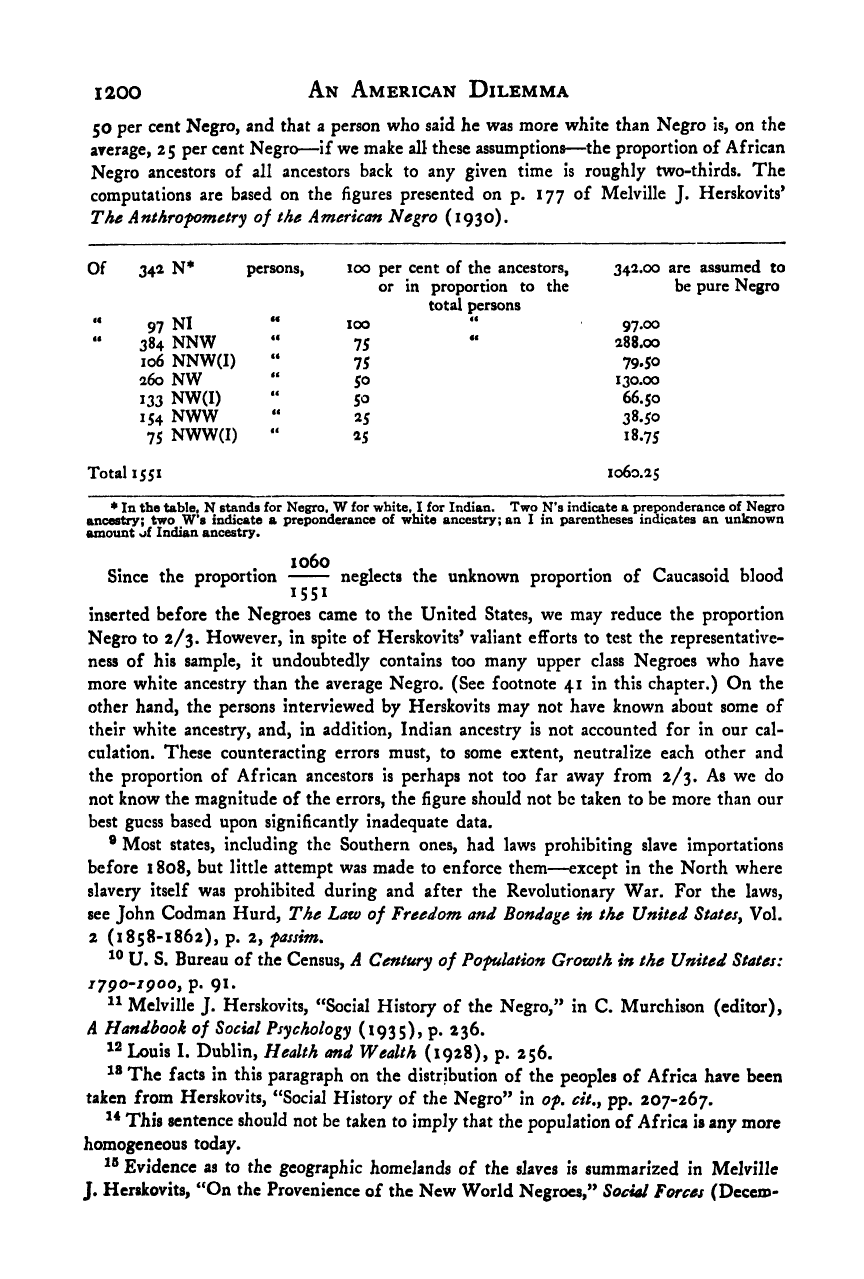Note: Gunnar Myrdal died in 1987, less than 70 years ago. Therefore, this work is protected by copyright, restricting your legal rights to reproduce it. However, you are welcome to view it on screen, as you do now. Read more about copyright.
Full resolution (TIFF) - On this page / på denna sida - Footnotes - Chapter 5

<< prev. page << föreg. sida << >> nästa sida >> next page >>
Below is the raw OCR text
from the above scanned image.
Do you see an error? Proofread the page now!
Här nedan syns maskintolkade texten från faksimilbilden ovan.
Ser du något fel? Korrekturläs sidan nu!
This page has never been proofread. / Denna sida har aldrig korrekturlästs.
1200 An American Dilemma
50 per cent Negro, and that a person who said he was more white than Negro is, on the
average, 25 per cent Negro—if we make all these assumptions—the proportion of African
Negro ancestors of all ancestors back to any given time is roughly two-thirds. The
computations are based on the figures presented on p. 177 of Melville J. Herskovits*
The Anthropometry of the American Negro (1930).
Of 34^^ N* persons, 100 per cent of the ancestors,
or in proportion to the
342.00 are assumed to
be pure Negro
total persons
«
97 NI «<
100
“
97.00
4 <
384 NNW 41
75 288.00
106 NNW(I) 44
75 79.50
260 NW 44
50 130.00
133 NW(I)
44
50 66.50
154 NWW 44
25 38.50
75 NWW(I) 44
25 18.75
Total 1551 1060.25
* In the table. N stands for Negro. W for white. I for Indian. Two N*s indicate a preponderance of Negro
ancestry; two W’s indicate a preponderance of white ancestry; an I in parentheses indicates an unknown
amount of Indian ancestry.
Since the proportion neglects the unknown proportion of Caucasoid blood
inserted before the Negroes came to the United States, we may reduce the proportion
Negro to 2/3. However, in spite of Herskovits’ valiant efforts to test the representative-
ness of his sample, it undoubtedly contains too many upper class Negroes who have
more white ancestry than the average Negro. (See footnote 41 in this chapter.) On the
other hand, the persons interviewed by Herskovits may not have known about some of
their white ancestry, and, in addition, Indian ancestry is not accounted for in our cal-
culation. These counteracting errors must, to some extent, neutralize each other and
the proportion of African ancestors is perhaps not too far away from 2/3. As we do
not know the magnitude of the errors, the figure should not be taken to be more than our
best guess based upon significantly inadequate data.
® Most states, including the Southern ones, had laws prohibiting slave importations
before 1 808, but little attempt was made to enforce them—except in the North where
slavery itself was prohibited during and after the Revolutionary War. For the laws,
see John Codman Hurd, The Law of Freedom and Bondage in the United States^ Vol.
2 (1858-1862), p. 2, passim.
U. S. Bureau of the Census, A Century of Population Growth in the United States:
jygo^igoo, p. 91.
Melville J. Herskovits, “Social History of the Negro,” in C. Murchison (editor),
A Handbook of Social Psychology (1935), p. 236.
Louis I. Dublin, Health and Wealth (1928), p. 256.
The facts in this paragraph on the distribution of the peoples of Africa have been
taken from Herskovits, “Social History of the Negro” in op, cit.y pp. 207-267.
This sentence should not be taken to imply that the population of Africa is any more
homogeneous today.
Evidence as to the geographic homelands of the slaves is summarized in Melville
J. Herskovits, “On the Provenience of the New World Negroes,” Social Forces (Decern-
<< prev. page << föreg. sida << >> nästa sida >> next page >>